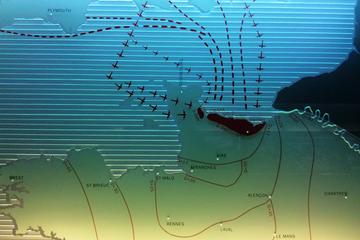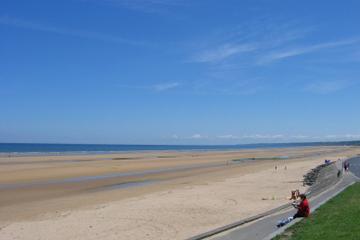
Paris, France
by Anne Harrison
Where else to begin exploring Paris, but where the city began? Walking through the Île de la Cité covers some 4000 years of civilisation, from when the first Gauls settled here to those living statues who now pose outside Notre-Dame for tourists.
Paris began her life on a boat-shaped island in the middle of the Seine. The city’s coat of arms proudly displays a boat tossed by the waves, above the motto fluctuat nec mergitu: she is tossed by the waves but does not sink. By the 3rd century BCE, the Parisii tribe had established a fortified settlement on what was to become the Île de la Cité, although other Celtic tribes had lived here from at least 2000 BCE. (Canoes dating back to almost 4000 BCE have been found on the banks the Seine.)
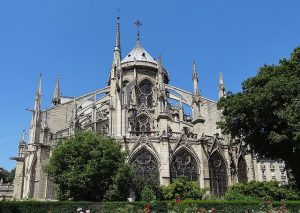 The Parisii chose well: a temperate valley of fertile lands, with a river not only full of fish but perfect for trading from the Adriatic to the Mediterranean. Beneath the surrounding hills lay stores of lime and gypsum – now known as plaster of Paris – later used to build La Ville Lumičre. So strategic a site, in fact, Julius Caesar invaded in 52 BCE, establishing a major Roman town – Lutetia (Lutčce) – which flourished until the Barbarian invasions.
The Parisii chose well: a temperate valley of fertile lands, with a river not only full of fish but perfect for trading from the Adriatic to the Mediterranean. Beneath the surrounding hills lay stores of lime and gypsum – now known as plaster of Paris – later used to build La Ville Lumičre. So strategic a site, in fact, Julius Caesar invaded in 52 BCE, establishing a major Roman town – Lutetia (Lutčce) – which flourished until the Barbarian invasions.
Le Crypte du Parvis de Notre-Dame stretches for some 120m beneath the Parvis de Notre-Dame (un parvis being a square outside a church). In 1965 work on a planned car-park uncovered archaeological finds dating not only from Roman times but back to the island’s first inhabitants. On view are Galleo-Roman ramparts and streets, rooms with an underground heating system called hypocaust, cellars, and remnants of the original Parisii wall.
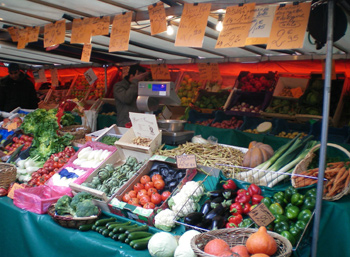 Emerge from the crypt, and the buttresses of Notre-Dame soar to the sky. This area had long been sacred; the Romans built a temple to Jupiter here (perhaps replacing a site of worship used by the Parisii), which in turn was replaced around 528 CE by the first Notre-Dame (built with stones from the Roman arena on the Left Bank).
Emerge from the crypt, and the buttresses of Notre-Dame soar to the sky. This area had long been sacred; the Romans built a temple to Jupiter here (perhaps replacing a site of worship used by the Parisii), which in turn was replaced around 528 CE by the first Notre-Dame (built with stones from the Roman arena on the Left Bank).
The Salian Franks invaded from Germany in the 400s, founding the first Frankish kingdom under Clovis in 466 CE. In 506 CE Clovis made Paris her capital, moving the royal court to the Île de la Cité (as it then became known). With the Royal Court remaining here until the 14th C, the island became the seat of royal and ecclesiastical power in Paris.
In 1163 Maurice de Sully, Bishop of Paris, began plans to replace Notre-Dame and St-Etienne with a large church suitable for the city’s growing population. Taking some 200 years to complete, and partly destroyed during the French Revolution, the cathedral remains a breath-taking wonder. Take time to climb her towers: the reward is not only an amazing view of Paris, but also coming face to face with the cathedral’s famous gargoyles.
 At 1 Parvis Notre-Dame stands the Hôtel-Hospitel Dieu. The first hospital in Paris, it was founded by Saint Landry in 651 CE, and still cares for ill Parisians. The ghosts of some 1300 years of medical history glide the marble corridors, whispering in consultation outside the wards before passing into the old-fashioned lifts to visit the fourteen quiet hotel rooms hidden on the sixth floor.
At 1 Parvis Notre-Dame stands the Hôtel-Hospitel Dieu. The first hospital in Paris, it was founded by Saint Landry in 651 CE, and still cares for ill Parisians. The ghosts of some 1300 years of medical history glide the marble corridors, whispering in consultation outside the wards before passing into the old-fashioned lifts to visit the fourteen quiet hotel rooms hidden on the sixth floor.
Victor Hugo brought the slums surrounding the Hôtel-Hospitel Dieu vividly to life in The Hunchback of Notre Dame, including Le Rue des Marmousets, one of the narrowest and darkest streets on the island. Until the 19th C, Notre-Dame was largely obscured by a maze of mediaeval streets and buildings.
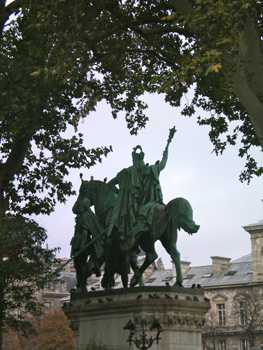 Under a burgeoning population the Île de la Cité had become a place where ‘plants shrivel and perish, and where, of seven small infants, four die during the course of the year’. (Victor Considerant, 1845). Diseases such as cholera proved epidemic. Authorities viewed the island as a cradle of discontent and revolution, where narrow streets were easily barricaded by paving stones – with the widest street measuring only 5m, the army had difficulty dislodging rioters.
Under a burgeoning population the Île de la Cité had become a place where ‘plants shrivel and perish, and where, of seven small infants, four die during the course of the year’. (Victor Considerant, 1845). Diseases such as cholera proved epidemic. Authorities viewed the island as a cradle of discontent and revolution, where narrow streets were easily barricaded by paving stones – with the widest street measuring only 5m, the army had difficulty dislodging rioters.
As a consequence, in the latter half of 19th C Napoleon III directed Baron Hausmann to renovate Paris. In redesigning the island Hausmann swept away alleys and homes, beggars and brothels, churches, cabarets, markets – and much of the island’s character. Coloured stones in the Parvis du Notre-Dame mark the outline of part of this mediaeval area plus its main thoroughfare, Le Rue de Neuve Notre-Dame. Nearby, a circular plaque marks kilomčtre zéro, from which all distances in Paris have been measured since 1768.
From here, wander down Le Rue d’Arcole. This eastern end of the island was once a city within a city, a maze of streets under the control of the Cloister of Notre-Dame. This is all that remains of a once bustling mediaeval heart, where the likes of Abélard studied and taught. Some mediaeval maisons remain, as do narrow streets such as Le Rue de la Colombe, which dates from the 13th C. Traces of the Gallo-Roman wall are outlined in paving stones on the street, and No. 4 boasts a door reputedly from the 13th C tavern which occupied the site.
 On the nearby Rue Chanoinesse, a 14th C baker was renown for his pâtés – until it was discovered they were made from murdered foreign students. Both No. 22 and 24 are 16th C gabled canonical houses, while at No. 26 the entry is paved with tombstones. No.10 is reputed to be the house of Héloďse’s uncle, where she and Abélard fell in love.
On the nearby Rue Chanoinesse, a 14th C baker was renown for his pâtés – until it was discovered they were made from murdered foreign students. Both No. 22 and 24 are 16th C gabled canonical houses, while at No. 26 the entry is paved with tombstones. No.10 is reputed to be the house of Héloďse’s uncle, where she and Abélard fell in love.
Revolutionary Paris lies in the opposite direction. Le Rue de Lutčce, (taking its name from the original Roman settlement), leads from Hôtel-Hospitel Dieu to Le Boulevard du Palais. At its start, to the right lies the flower market, one of the few remaining in Paris. On Sundays it transforms into a bird-market, filling the streets with birdsong.
At No. 10 Boulevard du Palais is Le Cour du Mai. Crowds gathered here during The Revolution to watch condemned cross the courtyard from the adjacent Conciergerie to carts waiting to take them to the guillotine at La Place de la Révolution.
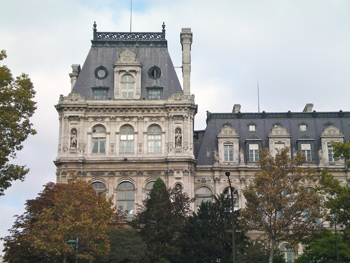 A short stroll but an ethereal world away is the Sainte-Chapelle. Often called “The Gateway To Heaven,” it was built by Louis IX between 1246-48 to house a piece of the True Cross and the Crown of Thorns. The upper chapel is considered one of the highest achievements of Gothic art. Many of the windows date from the 13th C, depicting Biblical scenes beginning with Adam and Eve and ending with the Apocalypse of the great Rose Window.
A short stroll but an ethereal world away is the Sainte-Chapelle. Often called “The Gateway To Heaven,” it was built by Louis IX between 1246-48 to house a piece of the True Cross and the Crown of Thorns. The upper chapel is considered one of the highest achievements of Gothic art. Many of the windows date from the 13th C, depicting Biblical scenes beginning with Adam and Eve and ending with the Apocalypse of the great Rose Window.
Pass back along Le Boulevard du Palais to Le Quai de l’Horioge. Le Conciergerie was built as an extension of the Capertian palace in the 14th C. The prisons held the likes of Marie Antoinette during The Revolution (her ghost has been seen both here and at Versaille); of the 4,164 ‘enemies of the people’ who passed through the Conciergerie during the Reign of Terror, more than half were guillotined.
 At the end of Le Quai de l’Horloge stand the Tour de César, Tour d’Argent, Tour de l’Horloge and the Tour de Bonbecis, all built between 1250 and 1300 as part of the now vanished Capetian palace. On the Tour de l’Horloge is Paris’ first clock, built in 1371. Along with parts of the Conciergerie, these towers and Saint Chapelle are all of this area to escape Hausmann.
At the end of Le Quai de l’Horloge stand the Tour de César, Tour d’Argent, Tour de l’Horloge and the Tour de Bonbecis, all built between 1250 and 1300 as part of the now vanished Capetian palace. On the Tour de l’Horloge is Paris’ first clock, built in 1371. Along with parts of the Conciergerie, these towers and Saint Chapelle are all of this area to escape Hausmann.
Where Le Rue de l’Horloge reaches Le Pont Neuf is La Place Dauphine. Made by joining two small islands to the Île de la Cité, it was designed by Henri IV as a discreet meeting place for bankers and merchants. Even today it brings a touch of the countryside into Paris. It opens onto the Pont Neuf, the oldest bridge in Paris. (It is actually two bridges.) The first stone bridge in Paris not lined by houses, the Pont Neuf was once a lively place where Parisians did their banking, were entertained by street performers, and could even have their teeth pulled. Reputedly, at any hour of the day, one would pass here a monk, a loose woman, and a white horse.
Beyond the Pont Neuf is Le Square du Vert-Galant, (the nickname of the amorous Henri IV). The square actually lies at the original level of the Île de la Cité during the Gallo-Roman period, some 7m lower then Le Parvis du Notre-Dame. A picnic spot for many Parisians, it is a perfect place to rest before exploring more of Paris.
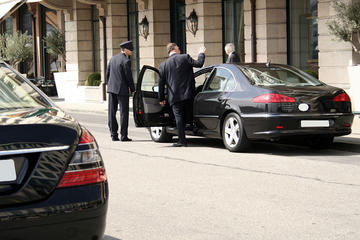
Private Car Service in Paris with Driver
If You Go:
Historic Paris Site
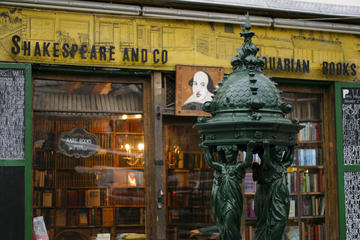
Literary Paris: Private Book Lovers’ Tour
About the author:
Anne Harrison lives with her husband, two children and numerous pets on the Central Coast, NSW. Her jobs include wife, mother, doctor, farmer and local witch doctor – covering anything from delivering alpacas to treating kids who have fallen head first into the washing machine. Her fiction has been published in Australian literary magazines, and has been placed in regional literary competitions. Her non-fiction has been published in medical and travel journals. Her ambition is to be 80 and happy. Her writings are available at anneharrison.com.au and anneharrison.hubpages.com
Photo credits:
Notre Dame gargoyle by Jawed Karim / CC BY-SA
Notre-Dame buttresses by Eutouring / CC BY-SA
All other photos by Anne Harrison:
The colours of a hidden grocer
The courtyard of the Hôtel-Hospitel Dieu
Statue of Charlemagne, Île de la Cité
The towers of the Conciergerien
The imposing Palais du Justice
Le Square du Vert-Galant
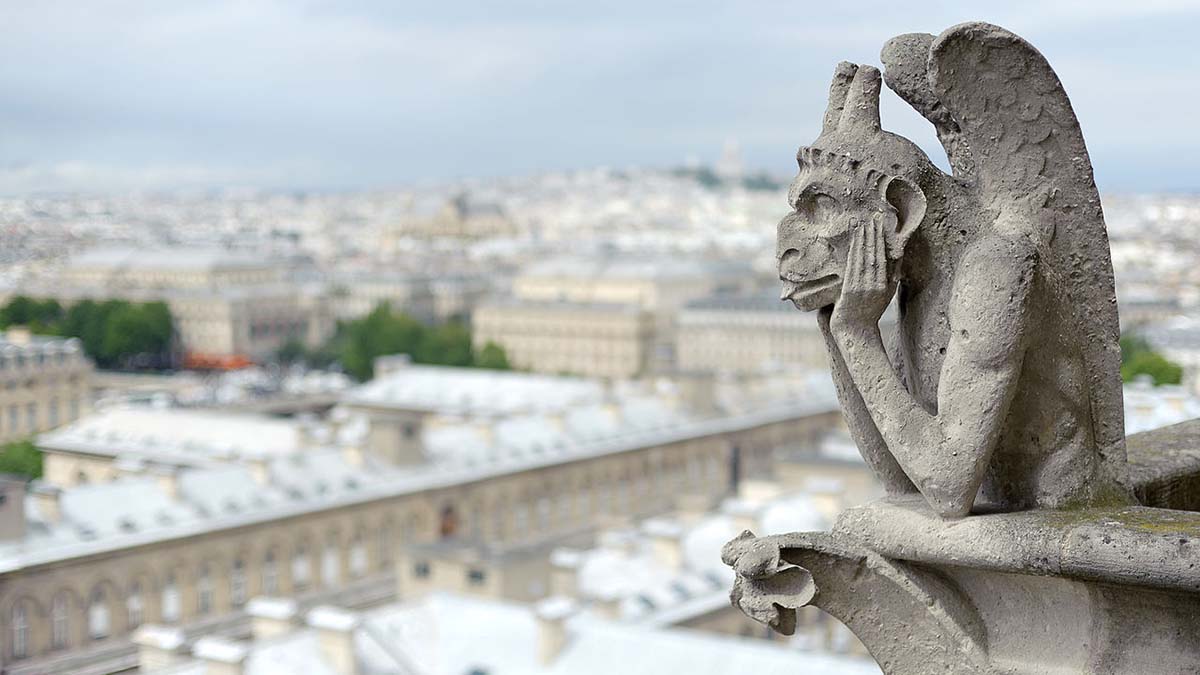



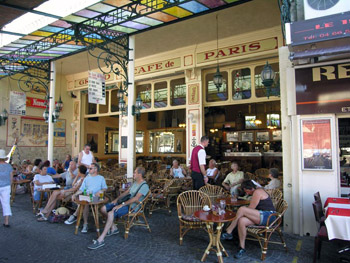
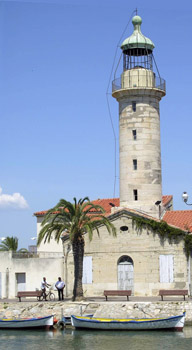 Since its birth fishing and transport have given it purpose and do so to this day, but it was to be the extension of the Nimes-Aigues Morte Railway to the town in 1909 which opened it up for tourism as a major economic driver. The president of France himself declared Grau du Roi a beach resort town in 1924.
Since its birth fishing and transport have given it purpose and do so to this day, but it was to be the extension of the Nimes-Aigues Morte Railway to the town in 1909 which opened it up for tourism as a major economic driver. The president of France himself declared Grau du Roi a beach resort town in 1924. Quai Charles de Gaulle and Quai Colbert occupy either side of the canal and offer a host of cafes and restaurants facing upon a canal full of moored craft of all sorts from recreational through to commercial fishing boats. Water traffic is constant and colourful. In fact colour is inescapable and enhanced under a smiling Mediterranean Sun.
Quai Charles de Gaulle and Quai Colbert occupy either side of the canal and offer a host of cafes and restaurants facing upon a canal full of moored craft of all sorts from recreational through to commercial fishing boats. Water traffic is constant and colourful. In fact colour is inescapable and enhanced under a smiling Mediterranean Sun.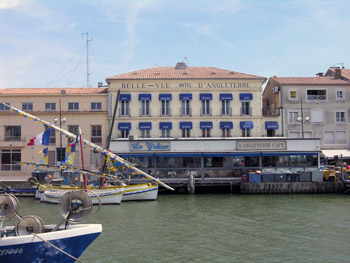 Where the canal meets the sea either shore stretches long and sandy to the left and right with Plage de Riv Gauche and Plage de Riv Droite. Shallow beaches afford a vast playground for waders and swimmers with ample shore space for sunbathers. Families, knots of chattering teenagers, a few topless strollers and more share the beach with hawkers advertising cool treats as they work their cumbersome wheeled kiosks across the beach. Sun screen and water socks are a good investment and more than a few bathers were spotted doing the hot sand dance across the beach.
Where the canal meets the sea either shore stretches long and sandy to the left and right with Plage de Riv Gauche and Plage de Riv Droite. Shallow beaches afford a vast playground for waders and swimmers with ample shore space for sunbathers. Families, knots of chattering teenagers, a few topless strollers and more share the beach with hawkers advertising cool treats as they work their cumbersome wheeled kiosks across the beach. Sun screen and water socks are a good investment and more than a few bathers were spotted doing the hot sand dance across the beach.
 Restaurants abound and we took in a pleasing meal at reasonable fare at a seasonal outdoor restaurant colonizing, with others, a tree shaded enclave; serenaded by by a chanteuse and her accompanying accordion player. The coolness of welcome shade, music and a fine meal reinforced the aura of southern France by the Mediterranean. Walk weary feet drank in comfort.
Restaurants abound and we took in a pleasing meal at reasonable fare at a seasonal outdoor restaurant colonizing, with others, a tree shaded enclave; serenaded by by a chanteuse and her accompanying accordion player. The coolness of welcome shade, music and a fine meal reinforced the aura of southern France by the Mediterranean. Walk weary feet drank in comfort.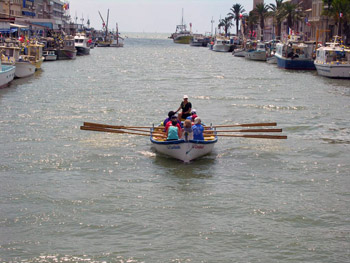 The other, workaday, side of town is revealed in the docks and moorings of craft toiling at sea with care taken towards functionality rather than appearance. Even so there is an aura about this long lasted foundation of the local economy. A business indifferently sharing waters and canal with recreational craft of varying opulence. Crossing Pont Tournant we stopped to watch an 8 man dory, six oars pushing water, making its way inland; its chanting rowers, ladies all, moving as one.
The other, workaday, side of town is revealed in the docks and moorings of craft toiling at sea with care taken towards functionality rather than appearance. Even so there is an aura about this long lasted foundation of the local economy. A business indifferently sharing waters and canal with recreational craft of varying opulence. Crossing Pont Tournant we stopped to watch an 8 man dory, six oars pushing water, making its way inland; its chanting rowers, ladies all, moving as one.


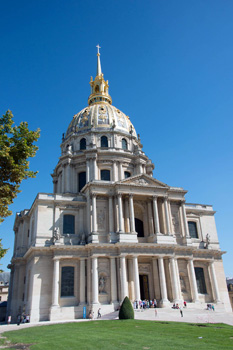 Beneath the golden vault of the Eglise du Dome Church lie the remains of the slight statured Corsican who became France’s greatest soldier. Within his massive crypt, Napoléon’s mystique looms large in death as it did during his lifetime. Hitler was so moved by his visit that as a tribute to the French emperor, he decreed that Napoléon’s son’s coffin be moved from Vienna to lie beside his father.
Beneath the golden vault of the Eglise du Dome Church lie the remains of the slight statured Corsican who became France’s greatest soldier. Within his massive crypt, Napoléon’s mystique looms large in death as it did during his lifetime. Hitler was so moved by his visit that as a tribute to the French emperor, he decreed that Napoléon’s son’s coffin be moved from Vienna to lie beside his father.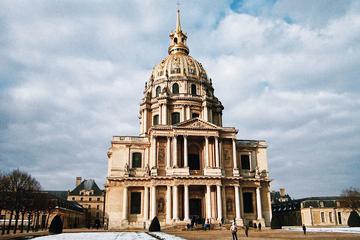

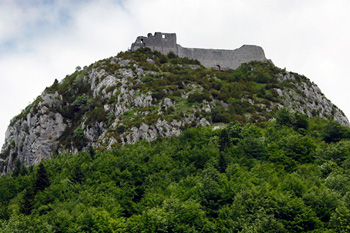
 The ruin of Montségur perches on a hilltop in the foothills of the Pyrenees. My arduous climb to this lonely crag is rewarded with panoramic views of lush hillsides dotted with purple blooming wild sage and silent sheep. All that remains of the castle are crumbling walls and part of a keep. A sighing wind whispers over the walls.
The ruin of Montségur perches on a hilltop in the foothills of the Pyrenees. My arduous climb to this lonely crag is rewarded with panoramic views of lush hillsides dotted with purple blooming wild sage and silent sheep. All that remains of the castle are crumbling walls and part of a keep. A sighing wind whispers over the walls. In contrast to the desolate loneliness of Montségur castle, Mirepoix is a bustling market town. Pastel coloured, half-timbered houses above wood frame arcades line the main square. Gargoyles on the church supervise the crowds around the curlicue adorned market. At the other end of the square sits the 14th century town hall. Each decorative wooden beam has a different carved head, demon, or animal.
In contrast to the desolate loneliness of Montségur castle, Mirepoix is a bustling market town. Pastel coloured, half-timbered houses above wood frame arcades line the main square. Gargoyles on the church supervise the crowds around the curlicue adorned market. At the other end of the square sits the 14th century town hall. Each decorative wooden beam has a different carved head, demon, or animal. On the opposite end of the spectrum from Montségur’s crumbling castle are the immaculately restored walls, bastions, and towers of Carcassonne’s Cité. Viewed across vineyards, the fortress stands as if from a fairy tale. Fortified since Roman times, Carcassonne was a Cathar stronghold in the Middle Ages. In the 1800s, Viollet-le-Duc imaginatively restored the double walls and the chateau they shelter. At a time when so many of France’s monuments were being neglected, he rallied for restoration. The project took fifty years and sadly, he did not live to see its glorious completion.
On the opposite end of the spectrum from Montségur’s crumbling castle are the immaculately restored walls, bastions, and towers of Carcassonne’s Cité. Viewed across vineyards, the fortress stands as if from a fairy tale. Fortified since Roman times, Carcassonne was a Cathar stronghold in the Middle Ages. In the 1800s, Viollet-le-Duc imaginatively restored the double walls and the chateau they shelter. At a time when so many of France’s monuments were being neglected, he rallied for restoration. The project took fifty years and sadly, he did not live to see its glorious completion.
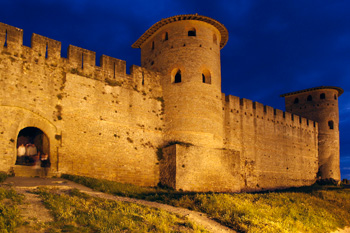 Inside the fortress, crowded narrow streets are lined with souvenir stands, restaurants, and half-timbered houses. I wander past patrons dining at tables under a leafy canopy, artists painting water colours and children in crusader outfits brandishing plastic swords. Two falconers, with their beady-eyed charges gripping their leather-gloved arms, add to the medieval atmosphere. On the grass lices between the long inner and outer sheer rock walls, I stroll in relative solitude past black slate roofed towers and square cut bastions. Carcassonne is a World Heritage Site and the fortress, while impressive by day, is stunningly lit at night. As the evening sky fades to a dusky blue and the spotlights come on, the fairy tale towers and walls glow golden. I readily imagine a centurion slowly patrolling the walls.
Inside the fortress, crowded narrow streets are lined with souvenir stands, restaurants, and half-timbered houses. I wander past patrons dining at tables under a leafy canopy, artists painting water colours and children in crusader outfits brandishing plastic swords. Two falconers, with their beady-eyed charges gripping their leather-gloved arms, add to the medieval atmosphere. On the grass lices between the long inner and outer sheer rock walls, I stroll in relative solitude past black slate roofed towers and square cut bastions. Carcassonne is a World Heritage Site and the fortress, while impressive by day, is stunningly lit at night. As the evening sky fades to a dusky blue and the spotlights come on, the fairy tale towers and walls glow golden. I readily imagine a centurion slowly patrolling the walls.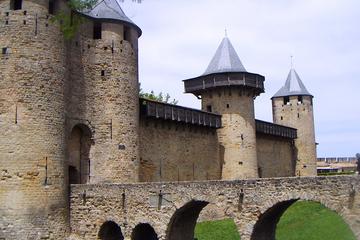
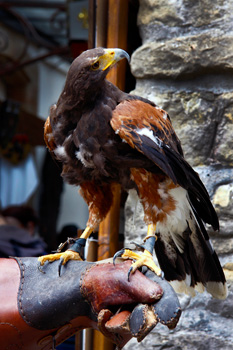 If You Go:
If You Go: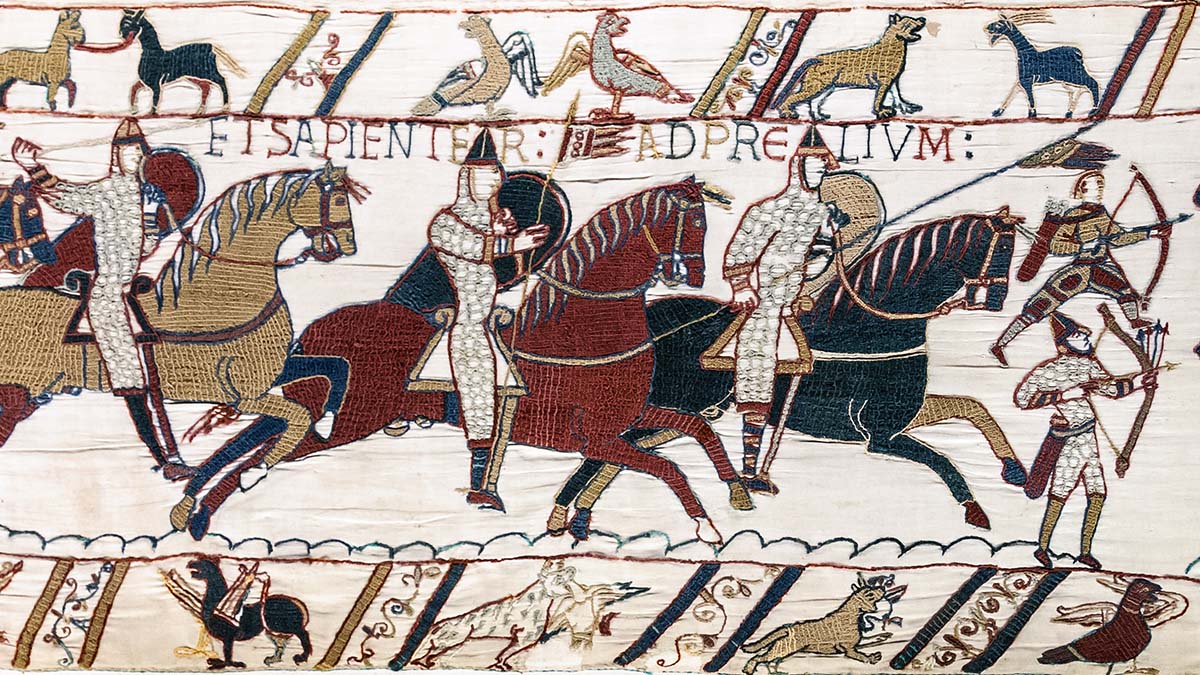
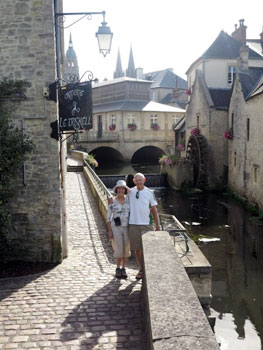 It’s Remembrance Day, 2014 and I’m interlocking the sleeves of my parents’ Air Force jackets. They are arm in arm once more, laid out on the bed. Mum, a coding and deciphering officer with the RAF, and Dad, an air observer/navigator with the 10th Squadron, Bomber Command, met at a dance in Gander, Newfoundland in December, 1944. They’d both already served five long years. I salute them. Then I hug their blue-gray wool serge, touch their caps, and straighten their belts.
It’s Remembrance Day, 2014 and I’m interlocking the sleeves of my parents’ Air Force jackets. They are arm in arm once more, laid out on the bed. Mum, a coding and deciphering officer with the RAF, and Dad, an air observer/navigator with the 10th Squadron, Bomber Command, met at a dance in Gander, Newfoundland in December, 1944. They’d both already served five long years. I salute them. Then I hug their blue-gray wool serge, touch their caps, and straighten their belts.
 A visit to Notre-Dame Cathedral’s Romanesque and Norman-Gothic edifice which pre-dates Mont-Saint-Michel was a must-see. It was consecrated in the fourth-century and flourished in King William’s reign. Its façade, chapter-house labyrinth, choir, as well as its fifteenth-century frescoes of angel musicians in the crypt, all captivate.
A visit to Notre-Dame Cathedral’s Romanesque and Norman-Gothic edifice which pre-dates Mont-Saint-Michel was a must-see. It was consecrated in the fourth-century and flourished in King William’s reign. Its façade, chapter-house labyrinth, choir, as well as its fifteenth-century frescoes of angel musicians in the crypt, all captivate. A yearning to be in the open air brings us to Velos Location: We rent bikes for eight hours at 16 Euros apiece and are transported to countryside where we hear the farmer’s tractor mowing hay. Or are those really tanks approaching? The trees that line the roads look mature, but aren’t they uniformly pushing the seventy years since peace was brokered? In 1944, trees provided fuel or defensive barriers on low-tide beaches, and their removal meant less shelter for an enemy. Today, those same trees flicker from shadow to light like newsreels, transmitting ticker tape noises to our spokes, and crank us forward.
A yearning to be in the open air brings us to Velos Location: We rent bikes for eight hours at 16 Euros apiece and are transported to countryside where we hear the farmer’s tractor mowing hay. Or are those really tanks approaching? The trees that line the roads look mature, but aren’t they uniformly pushing the seventy years since peace was brokered? In 1944, trees provided fuel or defensive barriers on low-tide beaches, and their removal meant less shelter for an enemy. Today, those same trees flicker from shadow to light like newsreels, transmitting ticker tape noises to our spokes, and crank us forward.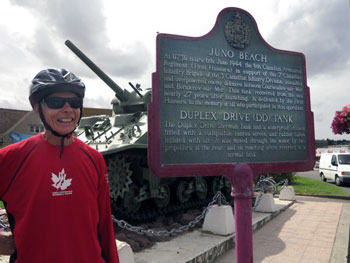 We chance upon the British Cemetery of War Graves of Bazenville-Ryes en route to Juno. Among its nearly 1000 souls, it shares the high ground with British, American, Canadian and German soldiers. The only borders here are lovely weed-free plantings of roses, oregano and lavender.
We chance upon the British Cemetery of War Graves of Bazenville-Ryes en route to Juno. Among its nearly 1000 souls, it shares the high ground with British, American, Canadian and German soldiers. The only borders here are lovely weed-free plantings of roses, oregano and lavender.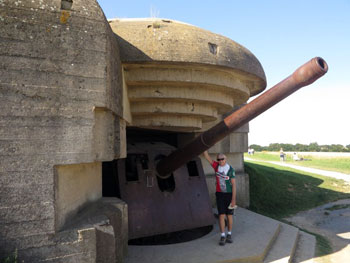 Longues-sur-Mer, the German Battery, still houses a 150-millimeter gun and four bunkers. Martine conducts the tour of the only battery to retain its original naval gun. These powerful long-range guns could have devastated had they functioned properly. The four guns were up, ready and firing over the 20-kilometer range, but a sand dune blocked the telescopic view for the shiny new range-finder still in its box. Without a range-finder, the guns fired blindly like big barking dogs, until direct hits silenced two of them just before the surrender.
Longues-sur-Mer, the German Battery, still houses a 150-millimeter gun and four bunkers. Martine conducts the tour of the only battery to retain its original naval gun. These powerful long-range guns could have devastated had they functioned properly. The four guns were up, ready and firing over the 20-kilometer range, but a sand dune blocked the telescopic view for the shiny new range-finder still in its box. Without a range-finder, the guns fired blindly like big barking dogs, until direct hits silenced two of them just before the surrender. This summer, 2014, we visited Portsmouth’s D-Day Museum to view the recently-completed Overlord Tapestry that commemorates D-Day. I met Mary Turner Verrier, a 91-year-old Red Cross Nurse and veteran of Dieppe, Dunkirk and D-Day. Mary treated casualties of war, both civilians and servicemen, primarily for flash burns.
This summer, 2014, we visited Portsmouth’s D-Day Museum to view the recently-completed Overlord Tapestry that commemorates D-Day. I met Mary Turner Verrier, a 91-year-old Red Cross Nurse and veteran of Dieppe, Dunkirk and D-Day. Mary treated casualties of war, both civilians and servicemen, primarily for flash burns.